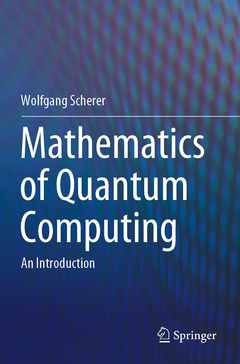Description
Mathematics of Quantum Computing, 1st ed. 2019
An Introduction
Author: Scherer Wolfgang
Language: English
Subject for Mathematics of Quantum Computing:
Keywords
Quantum computing math; Entanglement measures; Bell inequality; Quantum algorithms; Shor factorization algorithm; Grover search algorithm; Phase Estimation; Search for Hidden Subgroup; Quantum error correction; Quantum computing textbook; Textnook quantum computing; Text quantum information
Publication date: 11-2020
764 p. · 15.5x23.5 cm · Paperback
Publication date: 11-2019
764 p. · 15.5x23.5 cm · Hardback
Description
/li>Contents
/li>Biography
/li>Comment
/li>
This textbook presents the elementary aspects of quantum computing in a mathematical form. It is intended as core or supplementary reading for physicists, mathematicians, and computer scientists taking a first course on quantum computing. It starts by introducing the basic mathematics required for quantum mechanics, and then goes on to present, in detail, the notions of quantum mechanics, entanglement, quantum gates, and quantum algorithms, of which Shor's factorisation and Grover's search algorithm are discussed extensively. In addition, the algorithms for the Abelian Hidden Subgroup and Discrete Logarithm problems are presented and the latter is used to show how the Bitcoin digital signature may be compromised. It also addresses the problem of error correction as well as giving a detailed exposition of adiabatic quantum computing. The book contains around 140 exercises for the student, covering all of the topics treated, together with an appendix ofsolutions.
Introduction.- Basic Notions of Quantum Mechanics.- Tensor Products and Composite Systems.- Entanglement.- Quantum Gates and Circuits for Elementary Calculations.- On the Use of Entanglement.- Error Correction.- Adiabatic Quantum Computing.- Epilogue Appendices: A Elementary Probability Theory.- B Elementary Arithmetic Operations.- C LANDAU Symbols.- D Modular Arithmetic.- E Continued Fractions.- F Some Group Theory.- G Proof of a Quantum Adiabatic Theorem.- Solutions to Exercises.




